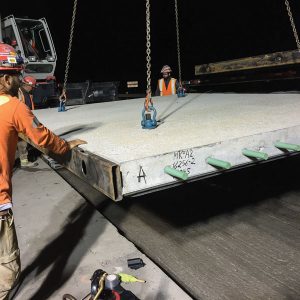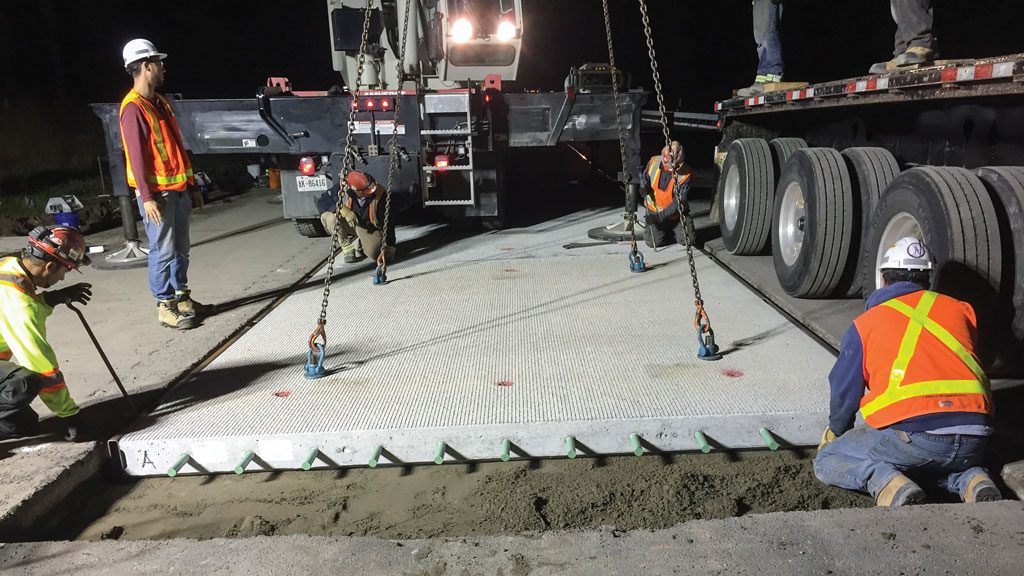The test scores are in and concrete slabs for highway repairs get an A plus grade from the Ministry of Transportation Ontario.
Never one to rush into any new technology, the MTO ran its first test of precast concrete slab repair on concrete pavements in 2004. That trial on Highway 427 in Toronto led to a specification and more precast repair work resulted.
At every step, the slabs have been a success leading to a pilot using precast concrete slabs to repair flexible pavement in a fall 2016 trial.
The results are positive: It costs more but there are savings in reduced traffic disruption and extended pavement life which more than offset the initial installation cost.
“We were not surprised by the findings,” says Stephen Lee, head of the MTO’s pavements and foundations section, materials engineering and research office. “And we will continue to monitor the long-term performance of this pilot.”
These slab repairs seem best suited for heavy truck traffic on asphalt pavements with 300 mm or more thickness but with more than 25,000 trucks per day which inevitably lead to rutting and premature deterioration.
Shave and pave, the standard treatment, only extends the pavement lifecycle three to five years. It’s far short of the eight to 12 years needed before the rutting, cracking and overall deterioration returns.
That’s what drove the MTO to look at literally milling out a section of pavement and dropping in precast slabs of concrete. It would be faster and ultimately more durable but would require precision cutting and high-level skills to get them seated and flush with the existing surfaces, says MTO’s Stephen Lee.
He says one of the big advantages is time because this type of rehabilitation work on busy highway sections must be done at night so as not to disrupt traffic flows.
The 2016 pilot project on the northbound section of Highway 400 between the intersections of Highways 88 (to the south) and 89 (to the north) tackled a section with average annual daily traffic in both directions at about 87,300.
They used the Fort Miller Superslab System with fully-cured precast concrete slabs and three different slab support systems for evaluation based on factors like load transfer and ease of construction. Time as also a consideration: could it be done within the overnight eight-hour window? And could horizontal and longitudinal joint details be figured out.
The slabs are just one option among many for pavement repair, Lee stresses and will not replace other options.
“This will be one of tools in the toolbox for the right pavement candidate,” he says. “This technique is suitable where ease and speed of construction (product is produced before field work begins) is a premium and where conventional rehabilitation of thick pavement layers cannot be achieved within an eight- hour closure window. The product is manufactured in a controlled environment to ensure enhanced product quality that could equate to longer lifecycle.”
The slab support systems were asphalt, grade and grout while instrumentation for long term monitoring came from a partnership with the University of Waterloo, Centre for Pavement and Transportation Technology (CPATT).
Some 22 reinforced precast sections were fabricated in late summer 2016 at the Armtec production facility in Mitchell, Ont. with a specific micro and macro surface texture to ensure friction.
After experimenting, a broom finish was found to be the best option, followed by longitudinal “tining” with constant pressure applied throughout.
Prior to milling out the sections, crews took core samples to ascertain asphalt depths. On the northbound lanes these came back at 355, 375 and 375 mm.
This left enough depth to rout out the asphalt leaving 150 mm of base for the 205 mm slabs which are a lane-width wide at 3.7 m and 4.6 m long. They were bonded with two mats of epoxy-coated dowels at 300 mm centres embedded at the transverse joints. Design strength rating was 30 MPa at 28 days with three-per-cent air void.
During installation over three nights, temporary longitudinal slabs were used as sleepers for transition from night to night.
Installation started Sept 20th, 2016 with seven to eight slabs, over three nights, for each of the three methods and it was all kept to a tight schedule, says Lee.
A Wirtgen Model W120 CFI milling machine with a 1.2 m-wide milling head proved to be the right choice for the asphalt supported method which also proved to be the fastest method. It required width with precise tolerances of plus/minus 3 mm.
There were some field adjustments, specifically re-milling an additional 12 mm to achieve the perfect grade. The CPATT instrumentation was installed beneath the fourth and eighth asphalt-supported slabs.

More interestingly was the time factor. Eight asphalt-supported slabs were laid in just over an hour, a rate of nine minutes per slab, followed by the temporary end slab. Fast-setting bedding grout, dowel grout and edge grout for longitudinal joints were applied the next night.
The second method tested were Grade Supported Slabs which also involved milling the asphalt, followed by placement, grading, and wetting the cement-treated bedding material (CTBM) prior to placing the precast concrete slab on top.
According to the report Lee wrote on the project, the CTBM was graded using a manual leveling screed and compacted using the plate tamper to the correct elevation. The material was wetted to begin hydration and the slabs were placed directly on this bedding layer. Installation time was about 13 minutes a slab.
The third test was for Grout Supported Slabs which were embedded with leveling screws. Once in place and level, quick-set bedding grout was then injected. Installation time was about 12 minutes a slab, Lee reports.
The process went well with only one of 22 not meeting the 3mm tolerance and needing diamond grinding.
Falling Weight Deflectometer tests showed the average load transfer efficiency (LTE) for all 23 joints was 80.3 per cent, well above the threshold of 70 per cent. Friction and roughness measurements were equally positive.
The pilot was a learning process with findings to apply to future installations, says Lee.
Milling must be precise, Bobcat-mounted chipping equipment worked faster than manually chipping the edges, slabs should be broom-finished at the plant, then diamond ground or grooved on site, as a post-installation process and saw cutting of longitudinal joints prior to milling is not needed, Lee reports, but transverse end joints should be saw-cut.
To speed things along, he recommends two crews with separate grout mixing equipment for dowel grout and bedding grout as the two grouts have different mixing consistency.
Overall, however reports Lee, the slab trial was a success. Moreover, it’s fast: At full production speed, 30 to 40 slabs could be placed in an eight-hour construction window, he says.
While the data suggests the Grout Supported Slab method is slightly better, the ministry prefers the Asphalt Supported Slab based on a cost-benefit analysis.
It was the fastest of the three techniques, precision milling achieves final grading and does not require additional bedding grout. Also, Lee says, the Asphalt Supported method using leveling screws would be a contingency where there are grade issues.
There’s still some work to be done, in addition to the monitoring to prove out the lifecycle projections.
“Ongoing monitoring results will be used to monitor the lifecycle cost of this option and the disruption cost will need to be analysed on a project-by-project basis.” he says. “Based on pilot project experience, a number of changes will be included in the specification to reduce the construction challenges faced by the crew. As with any new process there will still be a learning curve for a new crew.”






Recent Comments